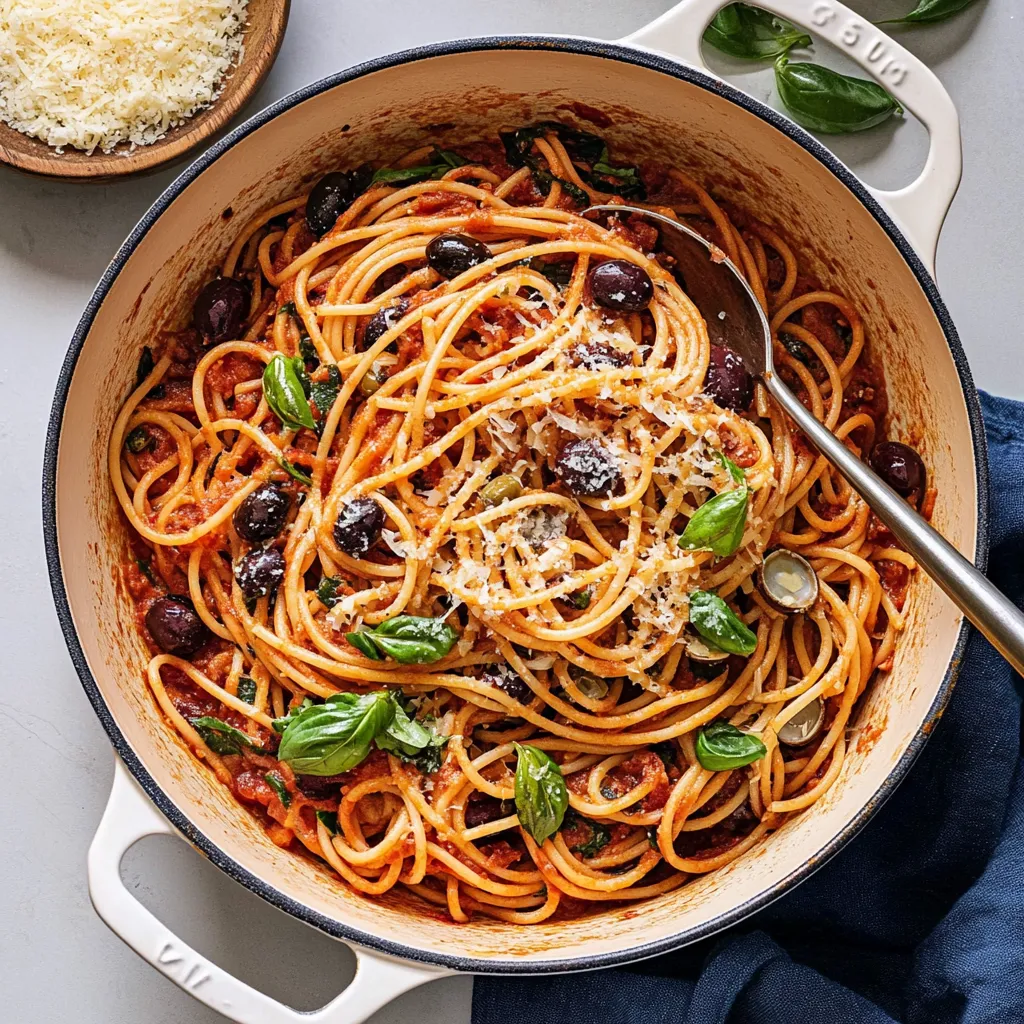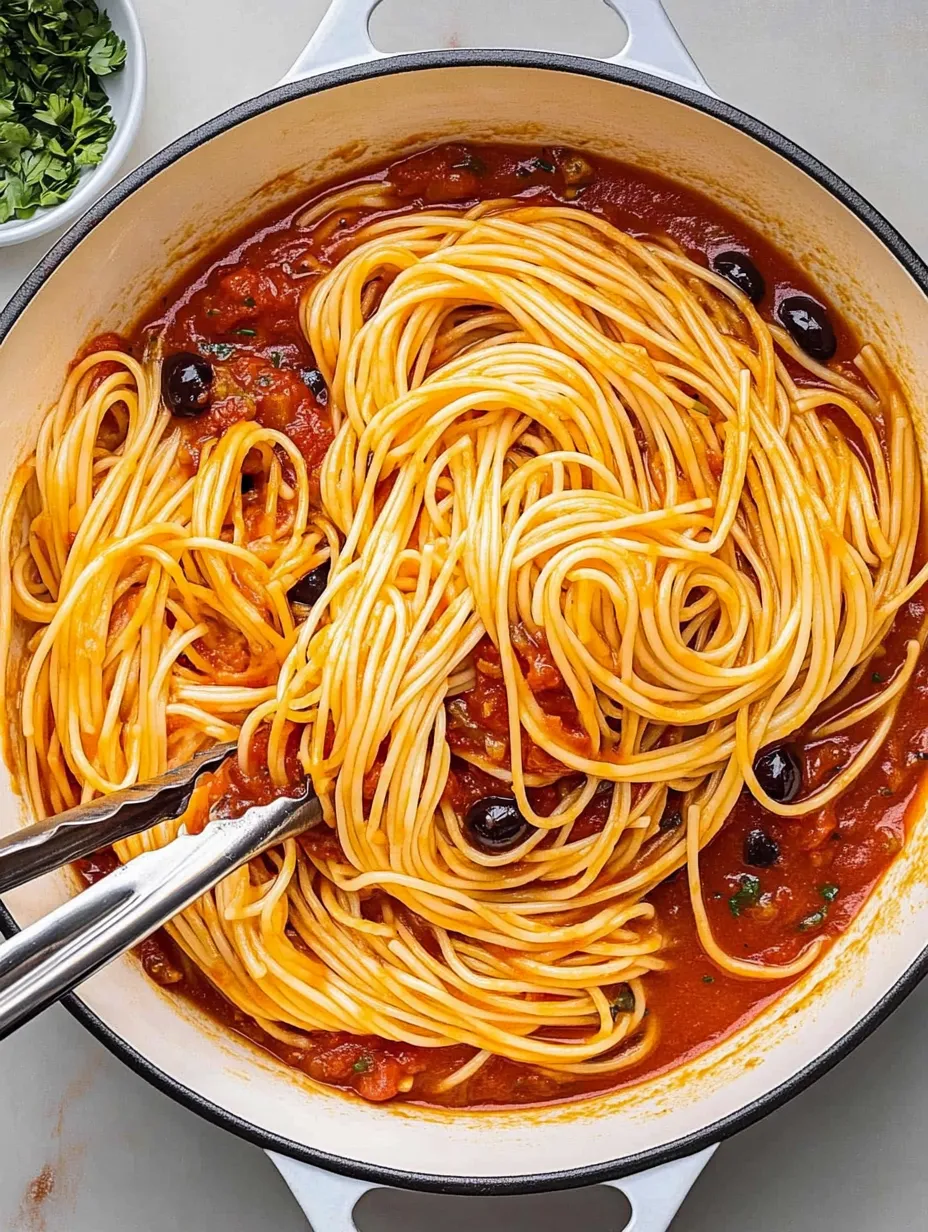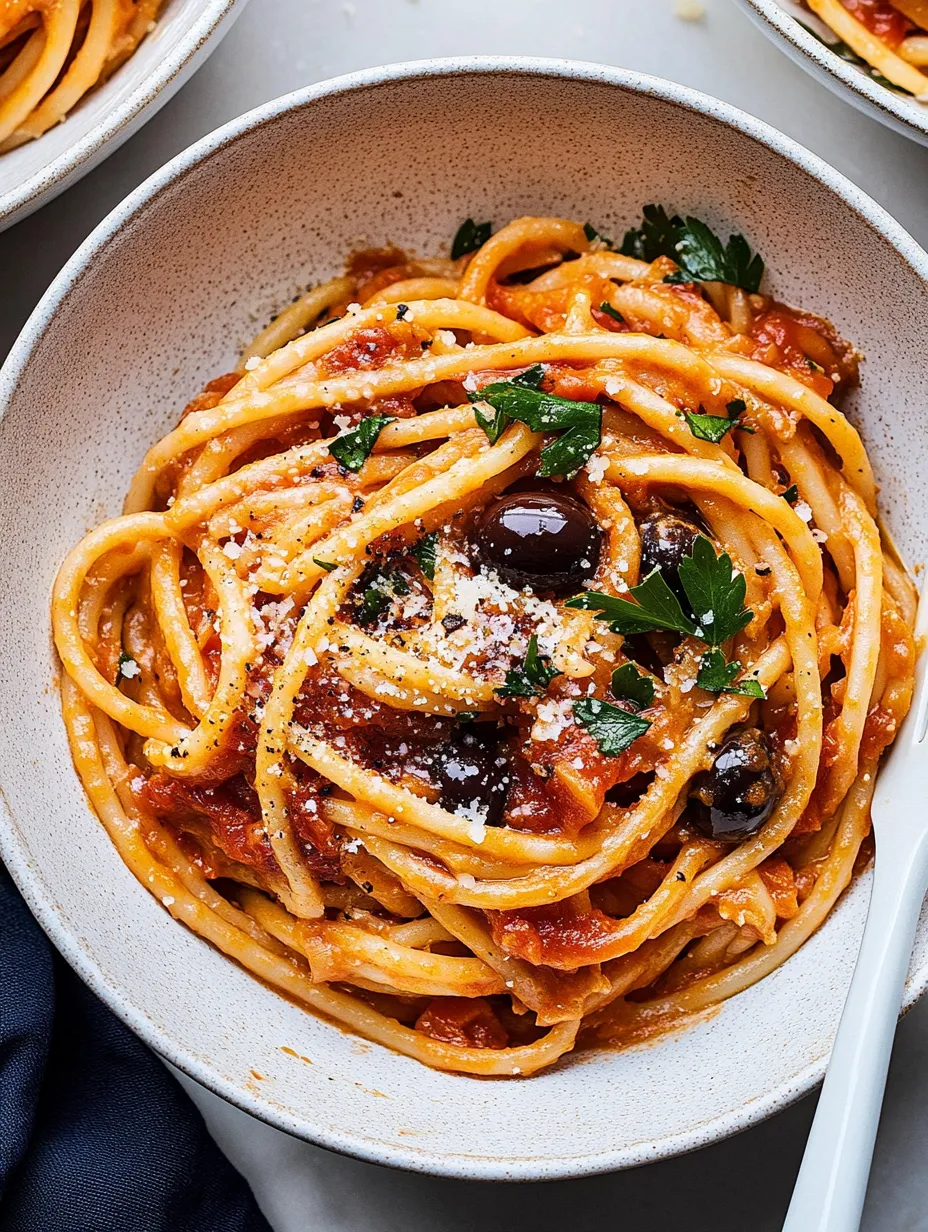 Pin it
Pin it
Pasta puttanesca transforms everyday pantry staples into a boldly flavored Italian masterpiece that comes together in just 30 minutes. This rustic dish combines the rich umami of anchovies, the briny punch of olives and capers, and the aromatic depth of garlic and herbs, all swimming in a vibrant tomato sauce that clings beautifully to al dente pasta. Whether you're cooking for a weeknight family dinner or impromptu guests, this no-fuss recipe delivers restaurant-quality results with minimal effort and ingredients you likely already have on hand.
I first made pasta puttanesca during a snowstorm when fresh groceries were impossible to come by. Rummaging through my pantry, I found canned tomatoes, a jar of olives, some capers, and a tin of anchovies—ingredients that had been sitting there for months. What began as a necessity quickly became one of our favorite meals; my daughter, who typically picks suspiciously at anything new, cleaned her plate and asked for seconds. Now we make it whenever time is short but we're craving something that tastes like it took hours to prepare.
Essential Elements
- San Marzano Tomatoes: These Italian plum tomatoes create the perfect sweet-acidic balance
- Anchovy Fillets: Melt into the oil, providing deep savory flavor without fishiness
- Kalamata Olives: Add meaty texture and distinctive briney-fruity notes
- Capers: Provide bright, tangy pops that cut through the rich sauce
- Quality Olive Oil: Forms the foundation that brings all flavors together
 Pin it
Pin it
Simple Steps
- Tomato Preparation:
- Start by preparing the tomatoes, which form the base of this flavorful sauce. Empty one 28-ounce can of whole San Marzano tomatoes into a large bowl. Using clean hands (the most effective tool) or the back of a wooden spoon, gently crush the tomatoes to create a chunky mixture with varying sizes of tomato pieces. This rustic texture is signature to authentic puttanesca—some tomato chunks should remain intact while others break down completely. Set aside while you begin building flavor in your pan.
- Flavor Foundation:
- In a large, deep skillet, heat 1/4 cup of good quality olive oil over medium heat. Add 4-5 anchovy fillets (don't worry if you're not an anchovy fan—they completely dissolve and leave no fishy taste, only rich depth). Using a wooden spoon, press the anchovies into the oil, helping them break down more quickly. After about 2 minutes, they'll nearly disappear into the oil. Add 4 thinly sliced garlic cloves and cook just until fragrant, about 30 seconds, being careful not to let them brown or they'll become bitter.
- Sauce Building:
- Pour the crushed tomatoes into the skillet with the anchovy-garlic oil. Add 1/2 cup pitted and roughly chopped Kalamata olives, 3 tablespoons drained capers, 1 teaspoon dried oregano, and 1/2 teaspoon crushed red pepper flakes (adjust according to your heat preference). Stir to combine all ingredients, then reduce heat to medium-low. Allow the sauce to simmer gently for 15-20 minutes, stirring occasionally. During this time, the flavors meld and intensify while the sauce slightly thickens. Season with freshly ground black pepper—additional salt is rarely needed as the anchovies, olives, and capers all contribute substantial saltiness.
- Pasta Perfection:
- While the sauce simmers, bring a large pot of water to a rolling boil. Add 2 tablespoons kosher salt (the water should taste like seawater), then add 1 pound of spaghetti or bucatini pasta. Cook until al dente according to package directions, usually 9-11 minutes. Before draining, reserve 1/2 cup of the starchy pasta water—this is liquid gold for adjusting sauce consistency. Drain the pasta but don't rinse it; the starch on the surface helps the sauce adhere better to each strand.
- Final Assembly:
- Add the drained pasta directly to the sauce in the skillet. Using tongs, gently toss until every strand is well coated with the vibrant sauce. If the sauce seems too thick, add a splash of the reserved pasta water to reach your desired consistency. Remove from heat and finish with a generous handful of freshly chopped parsley and torn basil leaves, which add bright color and fresh flavor to balance the intense sauce. Serve immediately in warmed bowls, topped with freshly grated Parmesan cheese if desired (though traditional purists might skip the cheese).
My friend Marco, who grew up in southern Italy, watched me make this dish with skepticism written all over his face. "Americans always complicate our simple food," he muttered as I worked. But when he took his first bite, his eyebrows shot up in surprise. "This tastes like my mother's," he admitted reluctantly, then proceeded to eat two full servings. Coming from someone who regularly criticizes restaurant Italian food as inauthentic, I took this as the highest possible compliment.
Serving Possibilities
This robust pasta stands beautifully on its own but pairs wonderfully with simple sides that complement without competing. A classic Caesar salad provides refreshing crunch alongside the hearty pasta. Crusty garlic bread offers the perfect tool for sopping up any remaining sauce. For wine pairing, choose a medium-bodied Italian red like Chianti or Montepulciano, which stand up to the bold flavors without overwhelming them. On warm evenings, a chilled pinot grigio provides pleasant contrast to the rich, savory sauce.
Creative Adaptations
While traditionalists might insist on following the classic recipe, puttanesca welcomes thoughtful variations. For additional protein, add chunks of oil-packed tuna or shredded rotisserie chicken during the final minutes of simmering. Create a vegetarian version by substituting the anchovies with a teaspoon of miso paste or soy sauce for similar umami depth. Add vegetables like sautéed mushrooms, bell peppers, or zucchini for extra nutrition and color. For a complete dietary change, serve the sauce over polenta, rice, or zucchini noodles instead of pasta.
 Pin it
Pin it
Storage Strategy
Puttanesca sauce actually improves with time as flavors continue to meld, making it perfect for meal prep. Store cooled sauce in an airtight container in the refrigerator for up to 4 days. For longer storage, freeze in portion-sized containers for up to 3 months. Thaw overnight in the refrigerator before reheating gently on the stovetop. Always store sauce separately from pasta when possible, combining them only when reheating and serving to prevent the pasta from becoming soggy.
I developed this version of pasta puttanesca during a particularly chaotic period when elaborate cooking wasn't possible but frozen pizzas had lost their appeal. This simple dish reminded me that extraordinary meals don't require extraordinary effort—just thoughtful preparation and quality ingredients. There's something deeply satisfying about transforming humble pantry staples into something so vibrantly flavorful that it feels like a special occasion dish. Yet it remains accessible enough for any Tuesday night when you want a meal that delivers comfort, satisfaction, and a little taste of Italy without much fuss.
Frequently Asked Questions
- → Can I make Pasta Puttanesca without anchovies?
- Yes, you can make Pasta Puttanesca without anchovies, though they do provide a distinctive umami flavor that's traditional to the dish. For a vegetarian version, substitute with 1-2 tablespoons of capers (in addition to the ones already called for) or add 1 tablespoon of miso paste dissolved in a little water. Another option is to use a splash of Worcestershire sauce (vegetarian versions are available) or a teaspoon of nutritional yeast. The flavor profile will be different but still delicious. If the issue is simply that you don't have anchovies on hand, anchovy paste can be used as a substitute (about 1 teaspoon equals 2 fillets).
- → What's the best type of pasta to use for Puttanesca?
- Traditional Pasta Puttanesca is typically made with long pasta shapes that can hold the chunky sauce well. Spaghetti is the most common choice, while bucatini (thick spaghetti with a hole running through the center) is fantastic as the sauce gets trapped inside the pasta. Other good options include linguine or fettuccine. If you prefer shorter pasta, penne or rigatoni work well as their tubular shape captures bits of tomato, olive, and caper. For a more authentic Italian experience, using bronze-die extruded pasta is ideal as its slightly rougher texture helps the sauce cling better to the noodles.
- → How spicy is this Pasta Puttanesca recipe?
- This Pasta Puttanesca recipe has a mild to medium heat level from the 1/4 teaspoon of crushed red pepper flakes. The spiciness is balanced by the acidity of the tomatoes and the brininess of the olives and capers, creating a warming rather than overwhelming heat. If you prefer a milder dish, you can reduce the red pepper flakes to just a pinch or omit them entirely. For those who enjoy spicier food, feel free to increase the amount to 1/2 teaspoon or more. You can always start with less and add more to taste while the sauce simmers. Remember that the heat will mellow slightly as the sauce cooks.
- → Can I make the sauce ahead of time?
- Absolutely! Puttanesca sauce actually improves in flavor when made ahead of time. You can prepare the sauce up to 3 days in advance and store it in an airtight container in the refrigerator. When ready to serve, gently reheat the sauce in a large skillet over medium-low heat, then cook your pasta fresh and combine. The sauce also freezes well for up to 3 months – simply thaw overnight in the refrigerator before reheating. For the freshest flavor when serving, add the chopped herbs after reheating rather than before storage. This make-ahead option makes Pasta Puttanesca perfect for meal prep or entertaining.
- → What sides pair well with Pasta Puttanesca?
- Pasta Puttanesca has such bold flavors that it pairs best with simple sides that won't compete with the main dish. A classic Italian green salad with arugula, lemon juice, olive oil, and shaved Parmesan makes a perfect light accompaniment. Garlic bread or a crusty Italian loaf is wonderful for sopping up extra sauce. For a more substantial meal, serve with sautéed broccolini or roasted asparagus tossed with olive oil, garlic, and lemon zest. If you're looking for an antipasto, a simple plate of good quality burrata or mozzarella drizzled with olive oil provides a creamy contrast to the bold sauce. For wine pairing, a medium-bodied Italian red like Chianti or Sangiovese complements the tomato-based sauce beautifully.
- → What can I substitute for kalamata olives if I don't have them?
- If you don't have kalamata olives, there are several good substitutes that will maintain the authentic flavor profile of Pasta Puttanesca. Black olives like Nicoise or Gaeta olives work very well. In a pinch, regular canned black olives will do, though they are milder in flavor. Green olives such as Castelvetrano can be used for a different but still delicious variation – they'll add a buttery quality to the dish. If using larger olives, be sure to pit them if necessary and chop them to a similar size as indicated in the recipe. Avoid using stuffed olives as their fillings may add unwanted flavors. Whatever olive variety you choose, look for ones packed in brine rather than oil for the most authentic puttanesca flavor.
